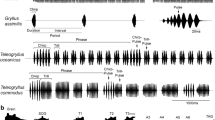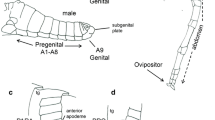Summary
Stridulation of grasshoppers is controlled by hemisegmental pattern generator subunits which probably are restricted to the metathoracic ganglion complex (TG3-complex). The coordination of left and right pattern generator subunits depends on commissures of the TG3-complex (Ronacher 1989). The coordination of the stridulatory movements was studied in Chorthippus dorsatus males with partial mediosagittal incisions in the TG3-complex.
Animals bearing anterior incisions in the TG3-complex, by which all commissures of the metathoracic neuromere and the first abdominal neuromere were transected, were still able to produce bilaterally coordinated species-specific stridulatory movements. Commissures of the T3- and A1-neuromere, thus, are not necessary, and the A2-, A3-commissures are sufficient for this coordination (Figs. 3, 4).
Animals with partial posterior incisions, extending until A1, had deficits in their stridulation pattern; the coordination between the hindlegs was impaired though not completely lost (Fig. 6). This is discussed in view of the structure of ‘stridulation interneurons’ identified in a related grasshopper species (Omocestus viridulus).
These results indicate an unexpected substantial contribution of the abdominal neuromeres A2 and A3 to the control of stridulatory movements. This constitutes an interesting parallel to the flight control system of locusts where interneurons located in the first 3 abdominal neuromeres also appear to contribute to the flight pattern generator (Robertson et al. 1982).
Similar content being viewed by others
Abbreviations
- A1–A3 :
-
abdominal neuromeres 1–3
- T3 :
-
metathoracic neuromere
- TG3-complex :
-
metathoracic ganglion complex including A1–A3
References
Burrows M (1975) Co-ordinating interneurones of the locust which convey two patterns of motor commands: their connexions with ventilatory motoneurones. J Exp Biol 63:735–753
Cruse H (1990) What mechanisms coordinate leg movement in walking arthropods. Trends in neuroscience 13:15–21
Cruse H, Knauth A (1989) Coupling mechanisms between the contralateral legs of a walking insect (Carausius morosus). J Exp Biol 144:199–213
Dean J, Wendler G (1982) Stick insects walking on a weel: Perturbations induced by obstruction of leg protraction. J Comp Physiol 148:195–207
Delcomyn F (1985) Walking and running. In: Kerkut GA, Gilbert LI (eds) Comprehensive insect physiology, biochemistry and pharmacology, vol 5. Pergamon, Oxford, pp 439–466
Dumont JP, Robertson RM (1986) Neuronal circuits: an evolutionary perspective. Science 233:849–853
Elsner N (1983) A neuroethological approach to the phylogeny of leg stridulation in gomphocerine grasshoppers. In: Huber F, Markl H (eds) Neuroethology and behavioral physiology. Springer, Berlin Heidelberg New York, pp 54–68
Elsner N, Huber F (1969) Die Organisation des Werbegesanges der Heuschrecke Gomphocerippus rufus L. in Abhängigkeit von zentralen und peripheren Bedingungen. Z Vergl Physiol 65:389–423
Elsner N, Popov AV (1978) Neuroethology of acoustic communication. Adv Insect Physiol 13:229–355
Foth E, Graham D (1983) Influence of loading parallel to the body axis on the walking coordination of an insect. II. Contralateral changes. Biol Cybern 48:149–157
Friesen WO (1985) Neuronal control of leech swimming movements: Interactions between cell 60 and previously described oscillator neurons. J Comp Physiol A 156:231–242
Friesen WO (1989a) Hierarchical organization of neuronal circuits that control animal locomotion. In: Erber J, Menzel R, Pflüger HJ, Todt D (eds) Neural mechanisms of behavior (Proc 2nd Intern Congr Neuroethology). Thieme, Stuttgart New York, pp 105–110
Friesen WO (1989b) Neuronal control of leech swimming movements. II. Motor neuron feedback to oscillator cells 115 and 28. J Comp Physiol A 166:205–215
Graham D (1985) Pattern and control of walking in insects. Adv Insect Physiol 18:31–140
Gramoll S (1988) Activity of metathoracic interneurons during stridulation in the acridid grasshopper Omocestus viridulus L. J Comp Physiol A 163:813–825
Gramoll S, Elsner N (1987a) “Stridulatory” interneurons in the metathoracic ganglion of the grasshopper Omocestus viridulus L. Naturwissenschaften 74:75
Gramoll S, Elsner N (1987b) Morphology of local “stridulation” interneurons in the metathoracic ganglion of the acridid grasshopper Omocestus viridulus L. J Comp Neurol 263:593–606
Hedwig B (1986a) On the role in stridulation of plurisegmental interneurons of the acridid grasshopper Omocestus viridulus L. I. Anatomy and physiology of descending cephalothoracic interneurons. J Comp Physiol A 158:413–427
Hedwig B (1986b) On the role in stridulation of plurisegmental interneurons of the acridid grasshopper Omocestus viridulus L. II. Anatomy and physiology of ascending and T-shaped interneurons. J Comp Physiol A 158:429–444
Hedwig B, Gramoll S, Elsner N (1990) Stridulatory interneurons in the metathoracic ganglion of the grasshopper Omocestus viridulus L. In: Gribakin F, Popov A, Wiese K (eds) Sensory systems and communication in arthropods. Birkhäuser, Basel, pp 183–187
Heitler WJ (1983) The control of rhythmic limb movements in Crustacea. In: Neural origin of rhythmic movements. Symp Soc Exp Biol 37:351–382
Helversen D von (1972) Gesang des Männchens und Lautschema des Weibchens bei der Feldheuschrecke Chorthippus biguttulus L. J Comp Physiol 81:381–422
Helversen D von, Helversen O von (1983) Species recognition and acoustic localization in acridid grasshoppers: a behavioral approach. In: Huber F, Markl H (eds) Neuroethology and behavioral physiology. Springer, Berlin Heidelberg New York, pp 95–107
Helversen D von, Helversen O von (1987) Innate receiver mechanisms in the acoustic communication of orthopteran insects. In: Guthrie DM (ed) Aims and methods in neuroethology. Manchester Univ Press, pp 104–150
Helversen O von, Elsner N (1977) The stridulatory movements of acridid grasshoppers recorded with an opto-electronic device. J Comp Physiol 122:53–64
Hustert R (1975) Neuromuscular coordination and proprioceptive control of rhythmical abdominal ventilation in intact Locusta migratoria migratorioides. J Comp Physiol 97:159–179
Jan LY, Jan YN (1982) Antibodies to horseradish peroxidase as specific neuronal markers in Drosophila and grasshopper embryos. Proc Natl Acad Sci USA 79:2700–2704
Janiszewski J, Otto D (1989) Control of cricket ventilation by interneurons originating within the fused metathoracic-abdominal ganglion complex. Naturwissenschaften 76:31–32
Kriegbaum H (1989) Female choice in the grasshopper Chorthippus biguttulus. Naturwissenschaften 76:81–82
Loher W, Huber F (1966) Nervous and endocrine control of sexual behaviour in a grasshopper (Gomphocerus rufus L., Acrididae). Symp Soc Exp Biol 20:381–400
Miller PL (1960) Respiration in the desert locust. I. The control of ventilation. J Exp Biol 37:224–236
Otto D, Amon T, Prenzel T (1990) Phase resetting of the cricket's ventilatory rhythm by interneurons originating in the suboesophageal ganglion. Naturwissenschaften 77:341–343
Perdeck AC (1957) The isolating value of specific song patterns in two sibling species of grasshoppers (Chorthippus brunneus Thunberg and Ch. biguttulus L.) Behaviour 12:1–75
Peters BH, Römer H, Marquart V (1986) Spatial segregation of synaptic inputs and outputs in a locust auditory interneurone. J Comp Neurol 254:34–50
Ramirez JM, Pearson KG (1989a) Distribution of intersegmental interneurones that can reset the respiratory rhythm of the locust. J Exp Biol 141:151–176
Ramirez JM, Pearson KG (1989b) Alteration of the respiratory system at the onset of locust flight. I. Abdominal pumping. J Exp Biol 142:401–424
Robertson M, Pearson KG (1984) Interneuronal organization in the flight system of the locust. J Insect Physiol 30:95–101
Robertson RM, Pearson KG, Reichert H (1982) Flight interneurons in the locust and the origin of insect wings. Science 217:177–179
Ronacher B (1989) Stridulation of acridid grasshoppers after hemisection of thoracic ganglia: evidence for hemiganglionic oscillators. J Comp Physiol A 164:723–736
Ronacher B (1990) Contributions of brain and thoracic ganglia to the generation of the stridulation pattern in Chorthippus dorsatus. In: Gribakin F, Popov A, Wiese K (eds) Sensory systems and communication in arthropods. Birkhäuser, Basel, pp 317–323
Ronacher B, Helversen D von, Helversen O von (1986) Routes and stations in the processing of auditory directional information in the CNS of a grasshopper, as revealed by surgical experiments. J Comp Physiol A 158:363–374
Snow PM, Patel NH, Harrelson AL, Goodman CS (1987) Neuralspecific carbohydrate moiety shared by many surface glycoproteins in Drosophila and grasshopper embryos. J Neurosci 7:4137–4144
Stein PSG (1974) Neural control of interappendage phase during locomotion. Am Zool 14:1003–1016
Stein PSG (1977) A comparative approach to the neural control of locomotion. In: Hoyle G (ed) Identified neurons and behavior of arthropods. Plenum Press, London New York, pp 227–239
Stent GS, Kristan WB, Friesen WO, Ort CA, Poon M, Calabrese RL (1978) Neuronal generation of the leech swimming movement. Science 200:1348–1357
Tyrer NM, Gregory GE (1982) A guide to the neuroanatomy of locust suboesophageal and thoracic ganglia. Phil Trans R Soc Lond 297:91–123
Weeks JC (1981) Neuronal basis of leech swimming: Separation of swim initiation, pattern generation, and intersegmental coordination by selective lesions. J Neurophysiol 45:698–723
Weeks JC (1982) Synaptic basis of swim initiation in the leech II. A pattern-generating neuron (Cell 208) which mediates motor effects of swim-initiating neurons. J Comp Physiol 148:265–279
Author information
Authors and Affiliations
Rights and permissions
About this article
Cite this article
Ronacher, B. Contribution of abdominal commissures in the bilateral coordination of the hindlegs during stridulation in the grasshopper Chorthippus dorsatus . J Comp Physiol A 169, 191–200 (1991). https://doi.org/10.1007/BF00215866
Accepted:
Issue Date:
DOI: https://doi.org/10.1007/BF00215866




